Specifications
Price: $TBD
Claimed weight: 165.3 lb; Expert, 169.7 lb
Seat height: 32.8 in.; Expert, 34.1 in.
If you thought Honda was going to let Yamaha or any other brand beat it to the punch with manufacturing the first high-performance mini four-stroke, well, you thought wrong. This time, at least, Honda is first. The company had even taken a risk, because at the time the bike was being produced there was no class for a 150cc four-stroke in AMA amateur racing. But Honda was sure the off-road market was ready and willing to buy these little red rockets, regardless of racing regulations. For what it's worth, the FIM over in Europe had already decided that 150cc machines could race in the 85cc class.But there are also some underlying circumstances. There is the Honda decree that the company will only produce four-cycle engines, with a small asterisk after it reading "except for competition racing machines," leaving the door open for the survival of the two-stroke CR. This mini could be the signal that a total switchover is imminent. There is also the gap in the CR line between the 85cc two-stroke and the 250F, as the 125cc two-stroke is largely ignored for any type of racing. It could be that the CR85 is at the end of its cycle, and the future of four-strokes looks so promising that this CRF150R is just the stepping-stone to continuing innovations in engine design. Why wait any longer?We signed our lives away and met at the top-secret Honda Proving Grounds in California's Mojave Desert for a one-day ride under a cloak of secrecy, as this bike was slated as the big surprise at the upcoming Honda dealer's convention. Cameras could only be pointed in specified directions, cell phones were confiscated as we entered, and we were watched and warned about all the rules.One ride on this little rocket and it's obvious that minibikes are changed forever. It is going to, if allowed, take over in racing. Especially at the top ranks because, as with all the racing four-strokes, it makes more power and delivers it for a longer duration. It is easier to ride than an 85cc, so for even those lesser-skilled riders, it will be an advantage. And it provides a fun factor that will surely have adults wanting to ride it. Really small guys and a lot of ladies will be extremely happy, because this machine will fit them just right, too.So how did Honda get here? HRA, Honda's U.S.-based research and development arm, has had an interest in these bikes ever since a bunch of screwed-up adults like myself were stuffing hopped-up XR75, 80 and 100 motors into decent chassis, such as the CR80 or, more recently, going full-bore into a BBR aluminum frame. HRA has ridden a number of these bikes, and it seemed just a matter of time before the market aligned and there was enough demand to build such a machine.Dirt Rider proposed that the bike would come with an aluminum frame and be a full-on, no-compromise race bike. That shows we don't think too much about the real world when we do these speculations. Honda definitely tested bikes similar to our drawings, but when it comes time to set a retail price, some corners must be cut to make the CRF150R affordable and practical, hence the steel frame. Then aspects like sharing parts with the current CR85, such as suspension components, wheel parts and a lot of the trim, come into play. There are no magnesium covers on the engine like the larger CRF-Rs, and the clutch cover is not a two-piece, easy-to-change design. All this lowers the price as well as leaves room for improvements in the years to come.
The bike starts very easily thanks to the automatic decompression device, but lighting the 150 might be a little harder for a smaller rider because the kick swing is longer and starts higher than the 85. Then the bike purrs right into a high idle. It snaps to life with any crack of the throttle and revs with a ferocious quickness and a mean exhaust tone to match. This is not a playbike by any means, beginning with the sound, which is very similar to a 250F. It takes a little throttle to get going, and as with an 85cc two-stroke, you need decent clutch control. First gear, on both small-wheeled and large-wheeled bikes, is plenty low, and you'll likely never use it on a track. The bike pulls smoothly and linearly from the bottom-which seems to start at about 6000 rpm-all the way to a 14,300 redline. Interestingly enough, the bike makes its peak power at 12,500. According to one of the engineers on hand, the 150 was tuned that way for safety. It will teach kids to shift instead of letting the bike sit on the rev-limiter. Even past peak power, there is pull, but there is plenty of warning that the best method for speed is an upshift to keep the little motor in the meat. Concealed in the cases are some new tricks for the CRF line. The tiny piston has a very intricate dome build that squishes the fuel-air mixture into a tidy 11.7:1 compression ratio in the very oversquare 66.0mm by 43.7mm bore and stroke. The Unicam operates four steel valves (26mm intakes, 22.5mm exhaust); in Honda-speak, because they are so small and thus are already light, there's no need for titanium. In the real world, Honda knows that Dad is not expecting to rebuild this head every year for Junior; the steel valves will last longer (and cost less). There is an extra lobe on the cam compared with the bigger CRFs because now there are two exhaust rockers instead of the one forked arm of the bigger engines. Less room inside the head and the combustion chamber while still using the same size of spark plug as the big CRFs mandates this new design.But the question is, Is it fast? For a bike in the 85cc class, the answer is yes. It makes a little more peak power, and it definitely has a longer power pull in each gear. There is strong torque coming out of this powerplant, but it comes with rpm, not by heavy weights and long piston strokes helping to keep things spinning. The pull close to idle is similar to a small two-stroke, and the bike will bog just the same if it isn't wound up. It hauled around this 180-pound rider just fine, and all I saw from the kids riding the bike was their astonishment at the power.The clutch was typical Honda excellence, and shifting was just as good. The gear ratios were tight in the five-speed gearbox, with second through fourth taking turns on a typical track. Fifth comes into play on long straights, but first will take the tightest turn to get a call. There is very little compression braking, and the stoppers on this bike give great feel and are not too grabby for younger or less experienced riders. Fast or heavy guys could use a little more.
The chassis size and suspension were set up with bigger riders in mind, so it is a bit stiffer than the CR85. Setup between the regular-sized bike and the larger-wheeled Expert differs in the seat height, the slightly longer swingarm and the spring rates and setup of the suspension. Once rolling, the biggest difference is the larger-wheeled bike turns and steers better for a larger rider. Similar in character in every other way, the bikes seem set up for the 110- to 140-pound range, easily handling the bigger guys when needed. Some of the components have been beefed up in anticipation for the larger riders, specifically the wheel axle diameters going up 2mm front and rear compared with the 85cc to handle the expected pounding. The suspension does a good job of being plush and progressive and bottoms controllably; we hucked some pretty big jumps just to be sure. The action overall is good, but picky grown-up riders were able to feel some of the inconsistencies in damping in the fork. It isn't a high-tech sealed chamber system as on the big bikes. Small fry kids will get bounced around a little bit (especially on the big wheel), but the really quick youngsters will be able to ride the bike faster and harder in stock form than any of the two-stroke minis.We already mentioned that cost was the reason for the steel frame, but after spending a day flogging this bike to no end, we find it hard to say that the beer-can material (yeah, at this level I should have said soda can) would have provided better handling. In fact, it may have made the suspension setting and performance come under heavier scrutiny, causing needs for upgrades (and price increases) there as well.For sure, the bike feels a little heavier, especially to a smaller rider, but the longer power seemed to overshadow the weight in no time. Kickstarting the 150 is a little more of a drill for a kid, but they'd better learn sometime-or will those lucky little brats have e-start MX bikes by the time they grow facial hair? And we all know about the noise. Stock, these machines test at 95-96 decibels, but you know they'll be ridden close to houses and in backyards, so we hope someone comes out with quieter mufflers for those situations. If I were 11 again, I would ride this thing in my own backyard till I dug handlebar-deep ruts into the grass.Honda jumped the gun, got into the game in the lead and-we think-started something that will open up a whole new chapter in minibikes. We know other manufacturers have bikes waiting and ready, possibly holding off to see where the benchmark will be written. With everything but the final retail price set on this bike, we believe it's going to be a real hot seller; Honda did this one just right (even the so-called cost-cutting measures). We can't wait to go and have a lot of fun on these things as soon as this embargo is up, which since you're reading this, means right now! They will be in dealers very shortly. Truthfully, the CRF150R is the four-stroke minibike I've been trying to build for the last 20 years.

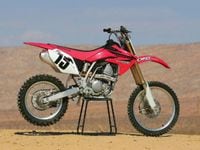
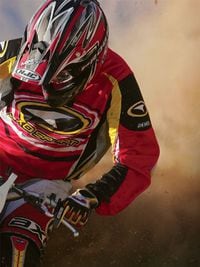
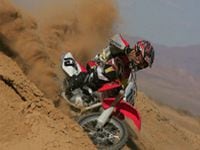
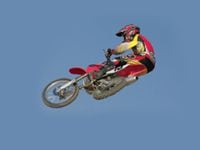

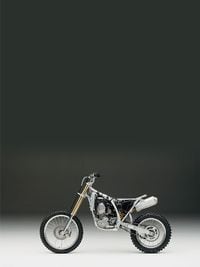
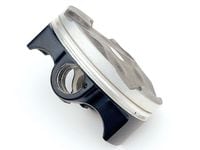
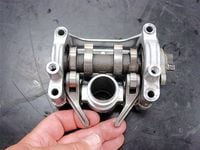
/cloudfront-us-east-1.images.arcpublishing.com/octane/TGSYZNI7UVEI7K7ULLVVQ324A4.jpg)
/cloudfront-us-east-1.images.arcpublishing.com/octane/XGKGRRHXPNDRBGPCV4FUAARLRE.jpg)
/cloudfront-us-east-1.images.arcpublishing.com/octane/4MNSJWN6UFEMTDQHVLM52C3X44.jpg)
/cloudfront-us-east-1.images.arcpublishing.com/octane/U6X2X4HGPNCYTNMPYOAN4IIJ5Q.jpg)
/cloudfront-us-east-1.images.arcpublishing.com/octane/B6ZIPVYSKVA3LHDJTGAEEMN4VM.jpg)
/cloudfront-us-east-1.images.arcpublishing.com/octane/I24MVSJBNZDALNIYUHHPVFWNZM.jpg)
/cloudfront-us-east-1.images.arcpublishing.com/octane/SIAXQ2ZOPNBYBLPKJPCHIYGG6A.jpg)
/cloudfront-us-east-1.images.arcpublishing.com/octane/2K6UXOH6I5E4HBKQVMPKA74RR4.jpg)
/cloudfront-us-east-1.images.arcpublishing.com/octane/B52ZU5WMNVF4FDYDONLARN26VU.jpg)
/cloudfront-us-east-1.images.arcpublishing.com/octane/7J4I2LIBRZB4DILKSLG54USBH4.jpg)
/cloudfront-us-east-1.images.arcpublishing.com/octane/LALZDRL5ORHUDGKA562HKNQQBM.jpg)
/cloudfront-us-east-1.images.arcpublishing.com/octane/4QSCGKH4JZACROBHROI55V6UBM.jpg)
/cloudfront-us-east-1.images.arcpublishing.com/octane/RMQHF3KBVVHVDAXXG66W7VFKMQ.jpg)
/cloudfront-us-east-1.images.arcpublishing.com/octane/3PZSH55PPRCILD6HP4LPQSQ6OY.jpg)
/cloudfront-us-east-1.images.arcpublishing.com/octane/RRB2FJLHGBGEBMP3R2Y4BUZH4M.jpg)
/cloudfront-us-east-1.images.arcpublishing.com/octane/SGDP7TBNIZCAXIPELLUO4EFFHI.jpg)
/cloudfront-us-east-1.images.arcpublishing.com/octane/7YYXO74VLVGOVB6QFDMMZSHW24.jpg)
/cloudfront-us-east-1.images.arcpublishing.com/octane/Y7MH6N6PXBA7XHNZUVMN2UONTU.jpg)
/cloudfront-us-east-1.images.arcpublishing.com/octane/YKVV7MAMARETDN3DBACJEEA7WI.jpg)
/cloudfront-us-east-1.images.arcpublishing.com/octane/EMYFSSH6N5CZZLDVVTM5M3QPWI.jpg)
/cloudfront-us-east-1.images.arcpublishing.com/octane/F4FOUTYVDBEIZIPVNBRDE4DI5A.jpg)
/cloudfront-us-east-1.images.arcpublishing.com/octane/OO3SHIQWLNCSNIKKXSB3YKVR6I.jpg)
/cloudfront-us-east-1.images.arcpublishing.com/octane/2KNSO5QWYVES7NNWEUVMPBGAKE.jpg)
/cloudfront-us-east-1.images.arcpublishing.com/octane/EIDNKNRSYRBBHFBWU42T2CNLUY.jpg)